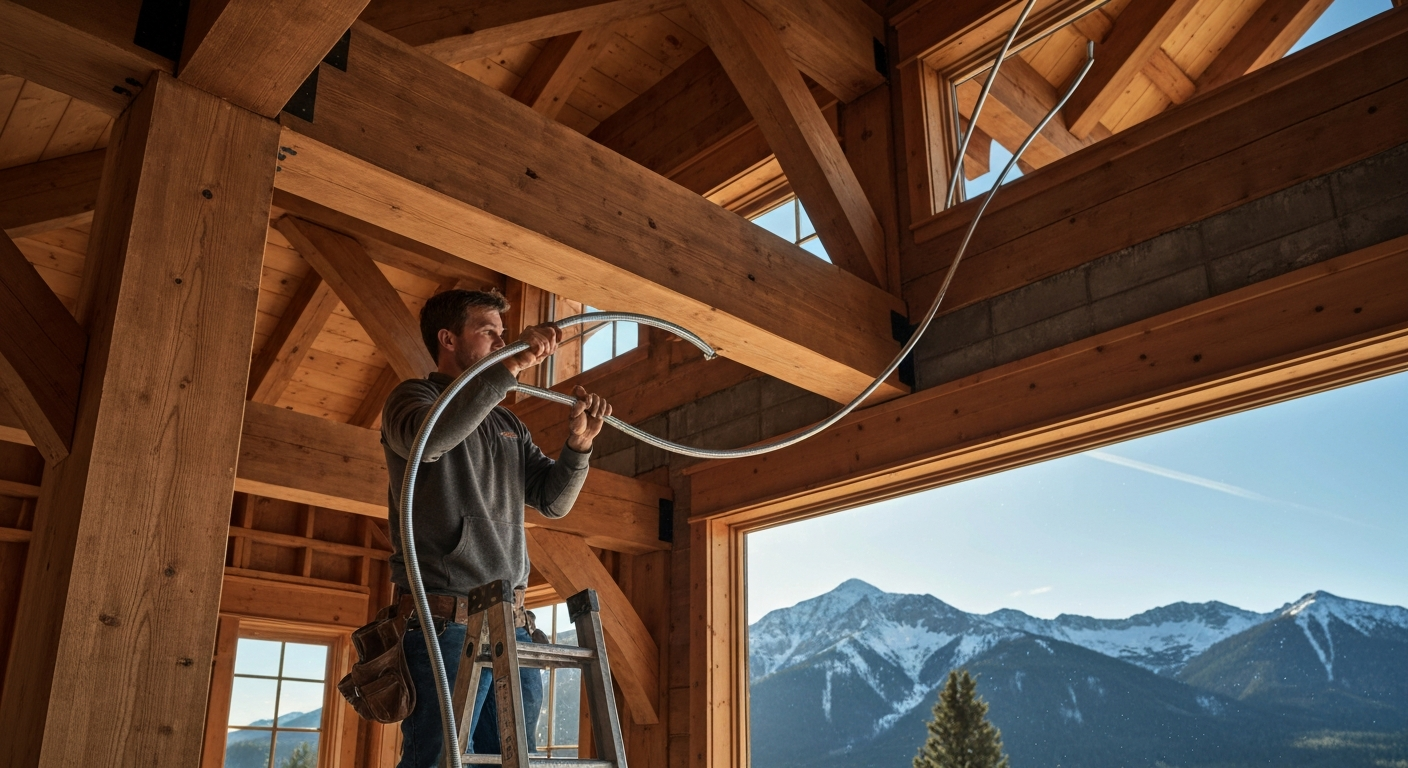
Wiring Methods for Colorado Mountain Homes: MC vs. Romex
For electricians working in places like Aspen, Vail, or Breckenridge, the decision involves navigating unique environmental factors and specific local electrical code amendments. This guide breaks down the critical factors to consider when you’re wiring mountain homes, helping you choose the right material for a safe and robust installation that will stand up to the harsh Colorado high country.
The Core Debate: MC Cable vs. Romex (NM-B)
At its heart, the choice between Metal-Clad (MC) cable and Non-Metallic (NM-B) cable, commonly known by the brand name Romex, is a trade-off between cost, installation speed, and physical protection. While both are workhorses in the residential world, their suitability changes when faced with the unique conditions of a mountain environment.
The Case for Romex (NM-B) Wire
There’s a reason romex wire is the default for a huge number of residential projects across the country. It’s affordable, familiar to every licensed electrician, and fast to install in protected wall cavities. Governed by NEC Article 334, NM-B cable is a perfectly acceptable and safe choice for standard interior branch circuit wiring when properly installed inside walls, floors, and ceilings that provide adequate physical protection.
However, its vinyl sheathing is vulnerable in exposed applications. In the rustic, open-beam designs common in mountain architecture, or in basements and garages where wiring might be run along surfaces, NM-B often requires additional protection, such as being run through EMT conduit. This can quickly negate its initial cost and speed advantages.
The Case for MC Cable: The Armored Advantage
This is where mc cable shines. Defined by NEC Article 330, its built-in metallic armor offers superior protection against physical damage. This makes it a prime candidate for a variety of challenges specific to mountain construction:
- Rodent-Resistant Wiring: This is a major factor. Mice, marmots, and other critters are notorious for chewing through the softer sheathing of NM-B, leading to hidden, hazardous faults. The metal jacket of MC cable provides a robust barrier, making it a form of rodent-resistant wiring that significantly enhances long-term safety.
- Exposed Installations: MC cable can be run in exposed locations without the need for conduit (where not subject to severe physical damage), making it ideal for the open-concept and rustic-industrial aesthetics popular in mountain lodges.
- Durability: The simple truth is that a mountain home is subject to more extreme expansion and contraction, and often more ongoing construction or modification (think ski storage additions or deck expansions). The inherent toughness of MC cable contributes to overall electrical system durability.
While making connections with MC requires specific anti-short bushings and connectors, and the material itself is more expensive than Romex, the labor savings from not having to install conduit in exposed areas often makes it the more efficient choice for complex mountain jobs.
Code Compliance in the High Country: NEC 2023 and Local Rules
Colorado’s mountain communities are diligent about code enforcement. Major jurisdictions like Pitkin County, Summit County, and Eagle County have all adopted the 2023 National Electrical Code. According to the Pitkin County Community Development Department, the county adopted the 2023 NEC effective August 1, 2023. Likewise, Summit County’s official website confirms it enforces the 2023 National Electric Code. Eagle County’s building department also states its use of the 2023 NEC. Keeping up with the latest standards is critical, and you can explore a summary of major updates in our breakdown of NEC 2023 key changes.
It’s important to note that while these AHJs are on the latest code cycle, there is no blanket local amendment mandating MC cable over Romex for all residential wiring. The decision is generally left to the installing electrician based on the specific conditions of the job. For example, a quick check of the Pitkin County electrical code reveals extensive rules around energy efficiency and outdoor systems, but not a universal pro-MC amendment. Always verify with the local building department for project-specific requirements.
Key code requirements like AFCI requirements and GFCI protection are, of course, strictly enforced. You’ll need to ensure all required circuits, especially in living areas, kitchens, bathrooms, and garages, have the proper protection, whether you’re installing a standard receptacle or a dedicated GFCI outlet.
High-Altitude Challenges for Electricians
Working at 8,000 feet or higher introduces variables that flat-landers never have to consider. These environmental factors directly impact your calculations and material choices.
- High-Altitude Derating: While not a common requirement for standard branch circuits in dwellings, it’s a concept every mountain electrician should understand. Some electrical equipment is tested and listed for operation up to a certain altitude (e.g., 2,000 meters or 6,600 feet). Above this, the thinner air is less effective at dissipating heat, potentially requiring equipment to be derated. This is more common with transformers and electronic equipment than with standard wiring, but always check manufacturer specifications. This concept is often called equipment derating, though it’s more about the equipment’s ability to handle heat at altitude.
- Ambient Temperature Correction: This is a far more frequent issue. Attics in mountain homes can bake under the intense high-altitude sun, reaching well over 120°F. Conversely, cold weather installation presents its own challenges, as cable sheathing can become brittle. You must apply correction factors to your conductor ampacity calculations based on the expected ambient temperatures the wiring will experience, as outlined in NEC Table 310.15(B)(1).
- Snowmelt and Outdoor Systems: Elaborate snowmelt systems for driveways and roofs are practically a necessity in these homes. These are power-hungry systems that demand dedicated circuits, careful load calculations, and robust GFCI protection. Some jurisdictions, like Pitkin County, even have regulations pertaining to the exterior energy use budget to manage the high demand of such systems.
Making the Right Connections
Regardless of your cable choice, the integrity of your system comes down to the connections. In an environment with dramatic temperature swings, ensuring every splice is mechanically and electrically secure is paramount. Using high-quality wire nuts or push-in connectors is non-negotiable. For a deeper dive into the pros and cons of each, consider reading our analysis on push-in vs. twist-on wire connectors. Furthermore, many faults don’t come from the wire itself but from errors in installation, especially with grounding. Avoiding the top grounding and bonding mistakes is just as crucial as choosing the right wire for the job.
Conclusion: The Best Choice is a Site-Specific Choice
So, what’s the final verdict for wiring mountain homes? There is no single right answer. For protected, standard-stud-bay wiring, Romex wire remains a cost-effective and compliant solution. However, for exposed runs, areas prone to pests, or any situation demanding maximum physical protection and long-term durability, MC cable is often the superior and more professional choice. An experienced electrician will likely use a hybrid approach, leveraging the strengths of both materials where appropriate. By understanding the unique environmental challenges, local code requirements, and the specific demands of high-altitude construction, you can deliver a safe, reliable, and durable electrical system that stands the test of time.
As codes evolve and new challenges arise, staying current with your knowledge is key. ExpertCE is here to help you stay at the top of your game. Browse our courses to find state-approved continuing education that fits your needs.
Colorado Continuing Education Courses
Explore our board-approved continuing education courses for Colorado professionals:
View CE RequirementsColorado 2023 NEC – 24 hours Electrical License Renewal Package
Disclaimer: The information provided in this educational content has been prepared with care to reflect current regulatory requirements for continuing education. However, licensing rules and regulations can vary by state and are subject to change. While we strive for accuracy, ExpertCE cannot guarantee that all details are complete or up to date at the time of reading. For the most current and authoritative information, always refer directly to your state’s official licensing board or regulatory agency.






